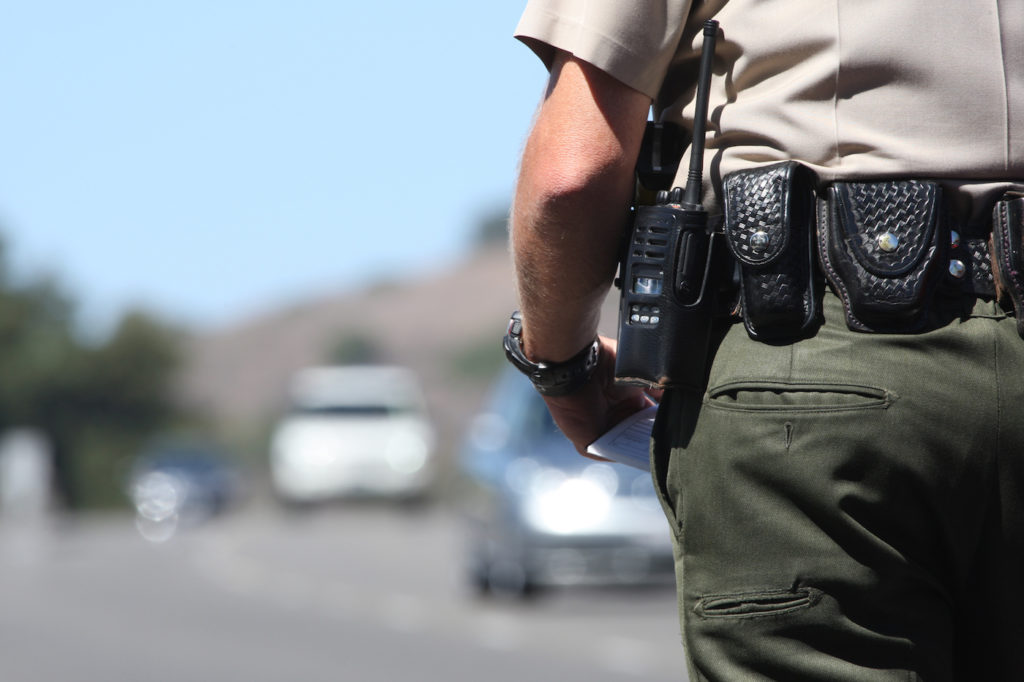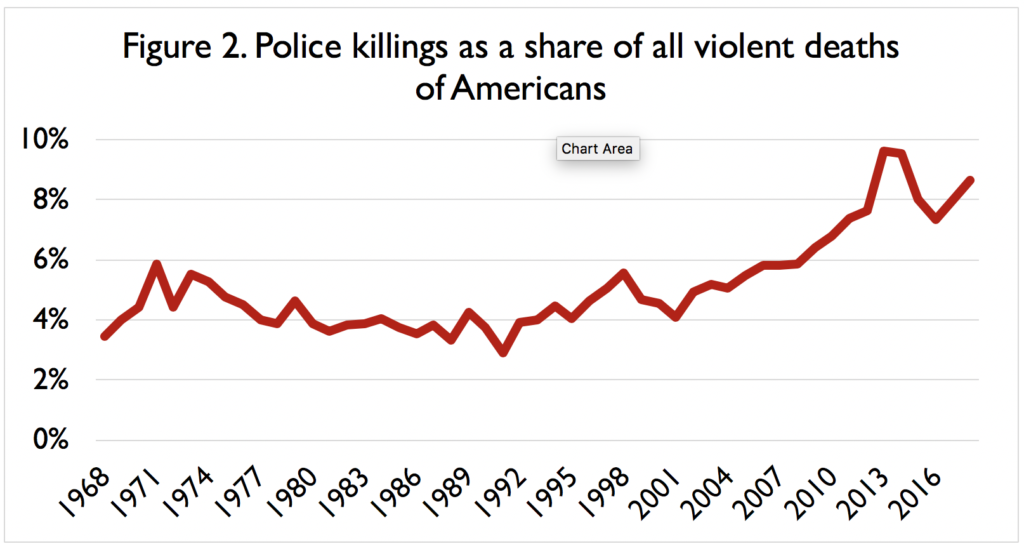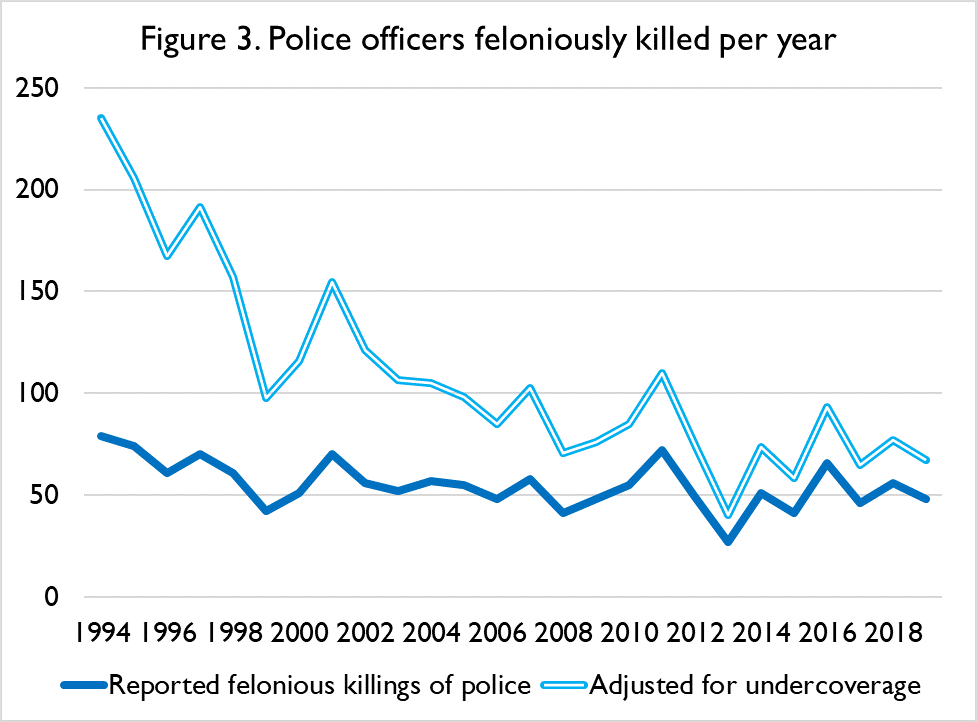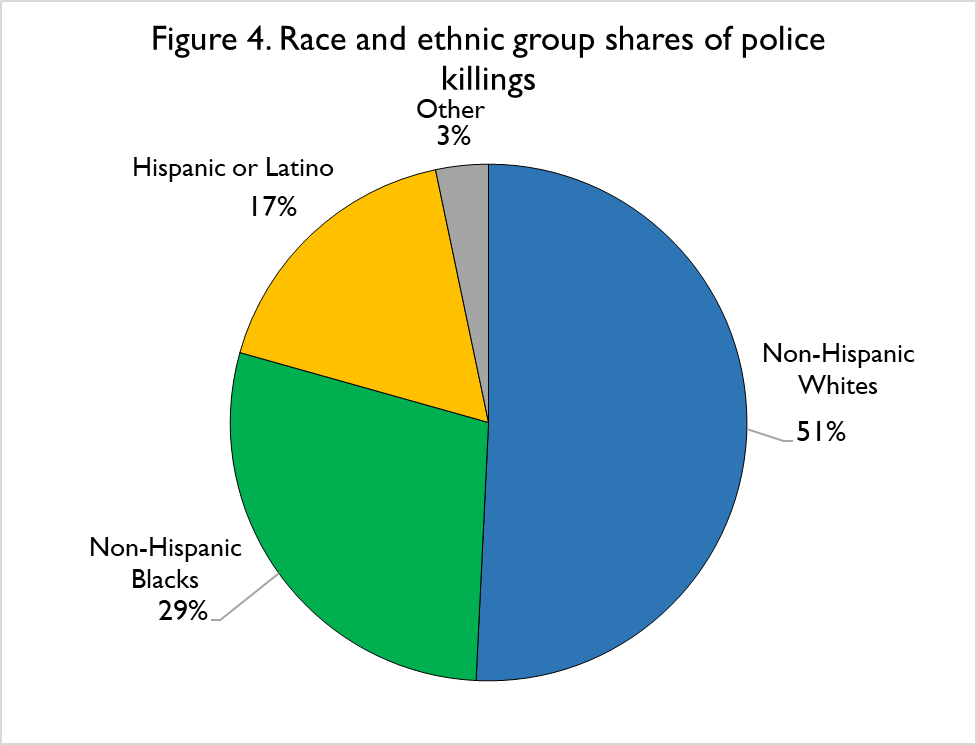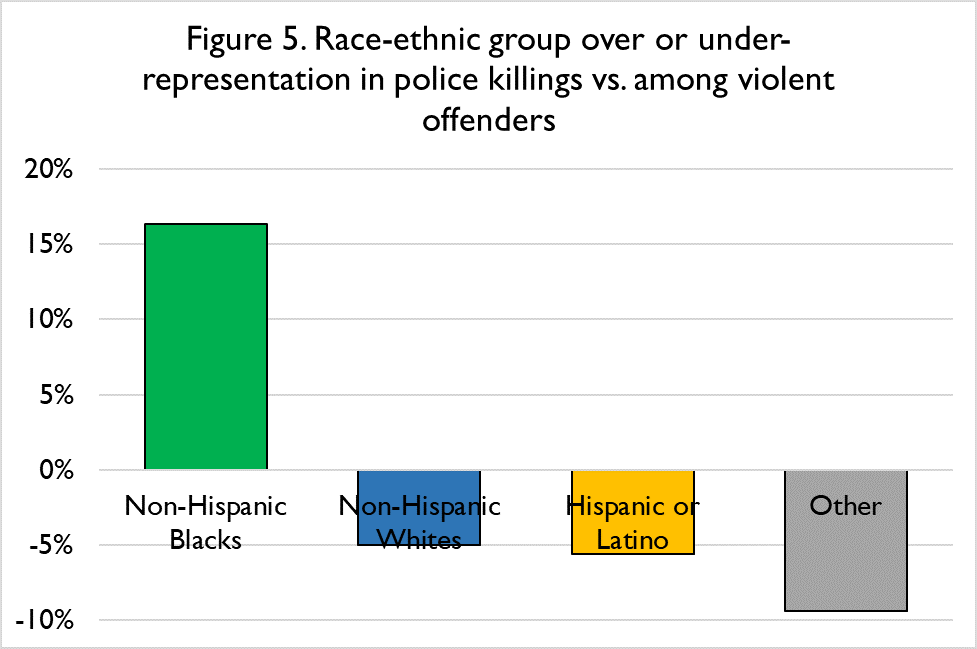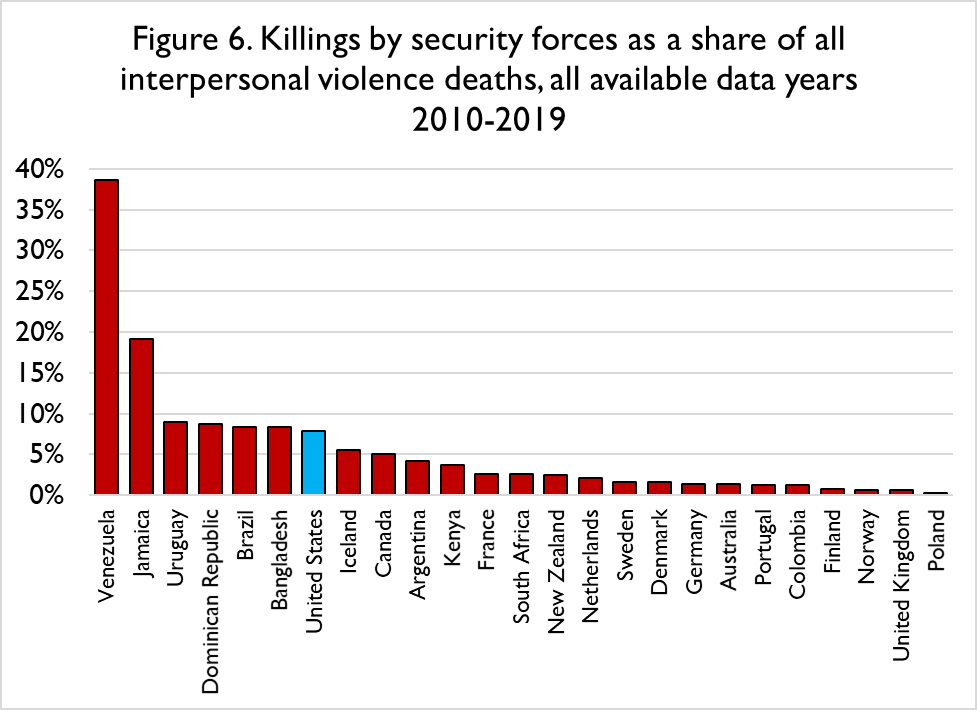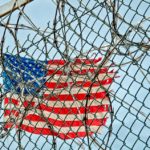This essay is part of our series on Race and Racism in America. See the full collection here.
Police officers kill about 1,700 Americans every year. In other words, police killings have made up about one out of every twelve violent deaths of Americans between 2010 and 2018. That’s including American military deaths in Afghanistan, Iraq, and elsewhere during that window. Indeed, more Americans died at the hands of police officers during that period (about 14,400) than died while on active military duty (about 9,400).
Police violence in America is extraordinary in its intensity. It is disproportionate to the actual threats facing police officers, and it has risen significantly in recent years without apparent justification. Its effects are felt across all racial groups, with non-Hispanic whites making up half of all people killed by police officers, even as African Americans are killed at disproportionately high rates compared to any reasonable baseline.
Police violence in America is extraordinary in its intensity. It is disproportionate to the actual threats facing police officers, and it has risen significantly in recent years without apparent justification.
Ultimately, high levels of police violence are a problem for all of society. They exemplify the increasingly unaccountable and militarized nature of police forces, over which elected officials struggle to maintain any kind of control.
Start your day with Public Discourse
Sign up and get our daily essays sent straight to your inbox.The Rise in Police Killings
Figuring out how many people are killed by police can be a daunting task. There are many data sources on killings by police officers, but none manages to cover a long period of time and have a high degree of completeness in any given year.
The most complete estimates, which provide the 1,700 figure above, come from the Fatal Encounters database, which collects data by scraping local news sources, making FOIA requests of public agencies, searching legal databases, and using verified crowd-sourced information. This method is reliable, because it uses public verification (anybody can check a news report to see if the police really killed somebody), can be applied transparently around the country (local crime news is digitally available essentially everywhere), and is free of reporting biases or possible influence by police departments themselves. As a result, multiple academic studies using different methods have confirmed the accuracy of Fatal Encounters data.
Fatal Encounters data reach back to 2000, though before 2013 their accuracy probably diminishes, as fewer records were digitally available to researchers. However, some other data sources reach back further. The Centers for Disease Control’s official death statistics also track killings by police officers, extending back to 1968, but only if the death certificate expressly mentions a police officer, which isn’t always the case. Quite frequently, the certificate only lists physical cause of death (e.g., “gunshot”), not who caused it. CDC data are woefully incomplete: academic study suggests that the CDC’s method misses about half of police killings. The FBI’s Uniform Crime Reporting (UCR) system also tracks killings by police officers, but only if they are officially ruled as justified killings of felons, and even that database appears to under-report police killings. Furthermore, a considerable number of police departments fail to report their statistics to the FBI at all. Finally, a relatively new statistical system, the National Statistics on Violent Deaths database, promises to provide somewhat better statistics. However, it only began to be rolled out in 2003, and as of the latest data in 2017 still has only thirty-five states participating. Nonetheless, the figure below shows all available data on killings by police, with NSVD and FBI UCR data adjusted for incomplete coverage areas.
Using the year-over-year change in the most reliable data sources for each period, I estimate a likely “true pattern of police killings” over time. The data suggest that police killings were relatively high in the late 1960s, declined until the 1980s, rose in the mid-1990s before falling again, then rose during the 2000s. They have been approximately stable at high levels for the last several years.
Are Most Police Killings Justified?
It’s important to give the police a fair shake here: rising killings by the police could be justified by a variety of factors. If criminals are becoming more violent (or if society in general is becoming more violent), police violence in response might make sense. To assess this, I assembled a dataset of all deaths in the United States due to homicides, executions, police killings, military deaths, terrorist attacks, and deaths under unclear or suspicious circumstances, and compared it to my estimate of police killings. Figure 2 below shows police killings as a share of all violent American deaths.
The police share of violent deaths in the late 1960s was low in part because a lot of Americans were dying in Vietnam. That share spiked afterwards, but then fell again as murder rates exploded. But since 1992, the police have accounted for an increasing share of all violent deaths in America. The pace of increase has been especially dramatic since 2002. This calculation shows the frequency of police killings has risen by much more than criminal or terrorist violence, which suggests that rising police violence is probably not a response to rising criminal violence.
The frequency of police killings has risen by much more than criminal or terrorist violence, which suggests that rising police violence is probably not a response to rising criminal violence.
There’s another way to check and see if criminals have gotten more violent, too. Since 1994, the FBI has collected statistics on law enforcement officers killed in action (LEOKA). Again, reporting of the data is inconsistent and requires adjustments. But what data do exist suggest that killings of police officers have actually declined over time, both in raw and reporting-adjusted terms.
There are still other reasons to suspect that the rise in police killings is driven by the police becoming more violent in general, not by justifiable killings. One simple reason is that “justified homicides” reported to the FBI have not risen by much (shown in Figure 1), even though other sources show an increase in police killings. It stands to reason that a lot of the killings that departments don’t report as justified homicides are, in fact, not justified homicides.
In the Fatal Encounters database, only about 28 percent of cases have conclusive data attached about whether they were deemed justified or not. Of those, about 20 percent were ruled unjustified, despite the extremely generous legal treatment given to police officers under qualified immunity rules. This share was essentially flat across years for which data are mostly complete; for recent years, the justified share of resolved cases fell sharply, but that may simply be because of more unresolved cases.
But there’s more. Data from another database, called Mapping Police Violence, suggest that killings of unarmed people from 2013 to 2015 were only ruled as justified in about 50 percent of cases with complete data, versus 95 percent in cases with an armed victim (and about 83 percent in cases where the victim was officially but dubiously identified as armed, such as with a household object like a stapler or a hot glue gun). The share of killings involving armed suspects was basically flat between 2013 and 2019 in those data, which makes it unlikely that there was a huge spike in justified homicides, which are strongly correlated with victims being armed. While this doesn’t conclusively show that the rise in police killings is unjustified, it at least demonstrates that there is no positive evidence in favor of the view that the rise in killings is driven by justified killings or killings of armed people.
What Caused the Increase in Police Killings?
Sophisticated defenders of police conduct might argue that these correlations are in fact an argument for police violence: maybe police killings have succeeded in making criminals less violent through intimidation!
This is unlikely. First of all, the decline in killings of police officers came before the current rise in killings by police officers. Effects don’t precede causes. Furthermore, a recent study found that crime tended to rise after high-profile killings by police offices. These increases were driven not by criminals getting more dangerous or police facing blowback, but by police unions responding to criticism by organizing “slowdowns,” in which large numbers of police violated their oaths to protect the public and simply stopped doing as much police work. As a result, violent crime rose. Moreover, historically, police unionization has led directly to increases in police killings, but no change in crime.
While it’s certainly possible that police brutality might intimidate some criminals into less violence, it seems far more likely that rising police killings are due to well-demonstrated factors like police militarization and the over-expansion of legal protections for the police.
To summarize: police killings have risen despite no increase in social or criminal violence generally. Police killings have risen despite a decline in actual killings of police officers (and, as related data show, a decline in assaults of police officers, too). Police killings have risen, but this rise is not driven by reported officially justified homicides, nor is it associated with a larger share of police killings involving armed victims. Instead, what we’ve seen is a rise in police killings across the board, untethered from actual threats to society, with the victims often being unarmed innocents. About 15 to 25 percent of police killings are of unarmed people.
This killing is largely driven by the same kinds of bureaucratic malfeasance and self-dealing that conservatives have criticized in other public sector unions. When incompetent DMV workers are not fired, when abusive teachers are reshuffled around schools, when bureaucrats use administrative gimmicks to thwart the electorate’s desire to rein in excessive spending, we conservatives are quick to (correctly!) identify the pernicious work of public-sector unions. Whereas all workers should have some say in their employment conditions, such as via unionization, public-sector workers already get a say in their employment conditions without a union: they get to vote on who their boss is! Public sector unions give the bureaucrats double the “votes” of the rest of us.
Police unions, which cause higher rates of police killings by shielding bad cops from discipline, are an especially horrible case of the general problem. Police killing is not the work of vigilant warriors defending society at great personal cost, and sometimes going too far: it is the day-in, day-out petty tyranny of a taxpayer-funded bureaucratic lobby group. The difference is that, unlike other public sector unions, police unions have military-grade equipment they can use to violently crush protests against their abuses, and they are legally immune from most consequences. They’re teachers’ unions, but with tanks and endless get-out-of-jail-free cards.
Police killing is not the work of vigilant warriors defending society at great personal cost, and sometimes going too far: it is the day-in, day-out petty tyranny of a taxpayer-funded bureaucratic lobby group.
Busting up police unions would save lives, and in the past has been a Republican policy: Calvin Coolidge’s political claim to fame before the presidency was breaking the Boston police union!
Measuring Racial Bias
The rise in police killings should be concerning to everyone, but it has been especially concerning to activists on the left, due to the perception that police killings are racially biased.
Sorting out racial bias is tricky. Between 24 and 30 percent of victims of police killings are black, depending on which source is used. The figure below shows the racial and ethnic distribution of deaths in the Fatal Encounters database.
At 29 percent of police killings from 2000 to 2020, black Americans are killed far more frequently than their approximately 13 percent share of the population would seem to predict, which suggests there’s considerable racial inequity in police killings.
On the other hand, over 35 percent of people who kill police officers are black. If the median killing by police is in a situation similar to those that lead to killings of police, then maybe police are actually biased in favor of black people, i.e., black victims make up a smaller share of victims than of theoretical potential perpetrators.
But on the other other hand, only about 22 percent of violent offenders are black. If the median circumstance involving a killing by police involves a group behaviorally similar to violent criminals generally, then that would imply that there is some discrimination against black Americans, but much less than is implied by overall population comparison.
In other words, the extent of racial bias depends on the baseline. Those who wish to defend the police will argue that the median police killing is of a person who is best compared to cop-killers or other murderers, implying very little bias. Those who wish to critique the police will argue that the median police killing is of an average person with no particular similarity to criminals.
The Victims of Police Killings
It seems to me that the most reasonable baseline is violent criminals, but not the most extreme violent criminals, such as murderers and cop-killers. While many police killings are indeed of would-be murderers, most probably are not. About a fifth of police killings are ultimately ruled to be unjustified, and an unknown number involve innocent bystanders wrongly accused of a crime.
This can be further demonstrated using data on the circumstances that have led to police killings. In the Fatal Encounters database, each case is paired with a brief textual description of the situation, which makes it possible to get a sense of the kinds of situations that lead to police killings. Across all 28,000 cases, only 4 percent mention murder or homicide, only 3 percent mention assault, and only 8 percent mention any shooting or gunfire. Meanwhile, 7 percent mention traffic violations, 6 percent mention domestic disturbances, 4 percent are in the course of serving a warrant, and 5 percent involve drugs or alcohol. Over 20 percent of cases involve a call to the police. Of these cases where officers were probably dispatched in response to a call, domestic disturbances make up 13 percent of killings.
The people police kill are mostly not actual or likely murderers. They are more likely to be people whose police interaction began as a DUI, speeding ticket, public intoxication citation, or domestic disturbance call. Many are indeed criminals (though certainly not all), and many are indeed violent, but treating them as statistically interchangeable with murderers and cop-killers is absurd. The situations that lead to police killings are about as likely to be traffic stops as “shots fired.”
The people police kill are mostly not actual or likely murderers. The situations that lead to police killings are about as likely to be traffic stops as “shots fired.”
Naturally, police officers defending their conduct will always claim that they were fearing for their lives and acting in self-defense. Still, sworn officers of the law have a job to be less afraid than the rest of us. The entire reason for the existence of police is to have an organized class of people who, when faced with violent people, will not panic, and instead will use force in a manner prescribed by law.
Those of us who believe that police fill a vital function in society, and that violence is sometimes a necessary part of keeping the peace, should avoid being taken as gullible suckers by union reps defending their members. When a police officer says he felt his life was threatened by an armed suspect, and the weapon listed is “bottle of cologne” or “cell phone” or “hot glue gun” or “wasp spray” (all real claims made in actual cases in the Mapping Police Violence dataset), we should look askance at that defense. The people police kill are not hard-bitten homicidal maniacs. They should be compared to, at most, violent criminals generally, but in most actual cases they have more in common with petty or property criminals.
Racial Bias in Police Killings Is Real
With this comparison to violent criminals generally established as the most reasonable comparison, it’s possible to identify how proportionate police killings are to the makeup of the at-risk population. Dividing each racial group’s share of police killings by their share of violent offenders (as reported in the National Crime Victimization Survey) can provide a passable estimate of the extent to which police killings of a given racial group are disproportionate to their likely provocations of police officers.
Non-Hispanic whites are killed about 5 percent less often than would be expected based on their share of violent offenders in America, while non-Hispanic blacks are killed about 16 percent more often than would be expected. Hispanics and other minorities are killed even less frequently, although this may be due to less consistent reporting of race for these groups.
These ratios aren’t enormous, but they are significant. Assuming that disproportionate minority shares of police killings are due to police using lethal force too readily against those groups, eliminating this racial bias in police violence could save somewhere between 75 and 110 lives each year, and that’s without even considering the possibility that killings of non-Hispanic whites might also be higher than is justifiable or necessary.
However, this exercise, while informative, still falls short of really demonstrating that disproportionate police killings of minorities are caused by racial bias. For that, more formal academic study exploiting quasi-experimental conditions is necessary. Helpfully, such formal academic study exists.
Using the unpredictable and somewhat random patterns of 911 calls and what police happen to be dispatched in response as an approximation of a more formal randomized study, a team of economists recently demonstrated that white officers in particular are much more likely to use potentially lethal force against black citizens. When randomly dispatched into more heavily black neighborhoods, white officers’ odds of shooting someone quadrupled, while there was virtually no change for black officers. This study controlled for crime patterns at the time of day and in the neighborhood to which the officer was dispatched, and was able to observe black and white officers dispatched into the same neighborhoods, and the same officers dispatched into multiple different neighborhoods. It is by far the most robust study of racial bias in policing yet conducted, and found an enormous effect that can best be described as racial bias leading to excessive use of force, especially lethal force.
Racial bias in police killings is real.
This racial bias is a problem for all of us. The measure of a society is not how it treats its most elite people, but how it treats “the least of these.” None of us wants to live in a society where racial minorities are killed without regard for the law by the supposed enforcers of the law. But beyond the obvious problem in this social inequality, it is worth reiterating that, even with a large racial bias, black Americans still make up a minority of police killings: non-Hispanic whites make up half, and other minority groups make up the remainder. Black Americans are facing a uniquely severe case of a problem that afflicts us all, and their protests against police violence should be regarded as the canary in the coal mine on this issue.
What Is To Be Done?
Governments bear the sword. This is their central purpose: to command a monopoly on violence, and therefore reduce the amount of disorder and violence regular people have to suffer. This is why police exist. Even in societies where police are mostly unarmed, there are police killings. When societies try to get rid of the police, new violent actors arise to fill the void. Within forty-eight hours of protesters in Seattle declaring an anarchist commune, violent warlords attempting to secure a monopoly on violence had emerged. As long as humans remain imperfect, there will be conflict. Calls to have a society free of any sword-bearers are naïve denials of basic human nature.
Governments bear the sword. This is their central purpose: to command a monopoly on violence, and therefore reduce the amount of disorder and violence regular people have to suffer. This is why police exist.
However, the levels of police violence seen in the United States are higher than necessary. Data are available from a limited number of countries about killings by police and other government agencies conducted outside of wars and insurrections, and they show that police in the United States are unusually violent compared to the level of violence in American society on the whole.
Police in America account for about 8 percent of all homicides. This is on par with Bangladesh, Brazil, or the Dominican Republic. There’s a considerable step down after us, with the next countries being Iceland (where the baseline murder rate is extremely low), Canada, Argentina, and Kenya. The share of killings conducted by American police officers is unaccountably high even compared to our higher levels of violence generally.
Solving this problem won’t be as simple as activists make it out to be. America is a more violent society, and even with an end to our excessive police killings, we will still have much larger absolute numbers of killings than other countries, simply because we have more violence in general. The use-of-force reforms advocates claim will reduce police killings by 72 percent will probably have far more modest impacts.
Furthermore, tinkering around the edges with regulations on police won’t deal with the fundamental problem: American police are almost impossible to discipline. Legal immunity, strong unions, and a demonstrated willingness to abandon their sworn oaths to protect the public in order to make a political statement all render police forces a law unto themselves. In order to tackle the problem of excessive police violence, reformers will need to attack the system itself: an end to qualified immunity, complete obliteration of collective bargaining and unionization for police, and reduced provision of military-style weapons and training provided to local police forces. Without stripping the police of the political leverage that protects them from punishment, and the equipment that convinces peace officers that they are soldiers at war, no other reforms are likely to yield durable effects.
Luckily, it’s quite possible to take down public unions. Republicans in many states have passed right-to-work laws (which often exempt police unions from right-to-work provisions, ironically); even stronger measures could be implemented.
If serious efforts are made to bring some law and order into the riotous world of American policing, hundreds or thousands of lives could be saved. If no such effort is made, the killings may simply continue to increase.

